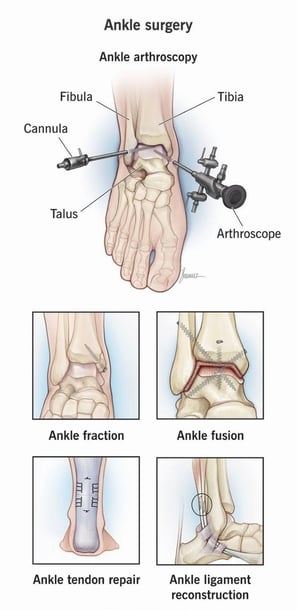Foot & Ankle treatments
ANKLE & FOOT


Introduction to Foot and Ankle Surgery
Foot and ankle surgery is a super-speciality branch of Orthopaedic surgery that addresses a variety of conditions affecting the lower extremities.
Orthopaedic surgeons with wide experience in treating Foot and ankle conditions provide precise treatment plan. Most of foot & ankle symptoms are managed non-surgically. Surgical treatments are often necessary when non-surgical treatments have failed to alleviate pain or restore function.
This guide will explore common conditions requiring surgery, types of procedures, preparation, post-surgery care, and recent advances in surgical techniques.
Common Foot and Ankle Conditions Requiring Surgery
Our feet and ankles support our entire body and help us stand, walk, run, and maintain balance. Various conditions can cause severe pain, change in alignment, and limit mobility, undermining the importance of surgical intervention. These conditions may involve:
⦁ Bunions: A bony overgrowth at the base of the big toe, often requiring surgical correction to relieve pain and restore alignment.
⦁ Achilles Tendon Disorders: Tears or ruptures of the Achilles tendon may require surgical intervention to repair the damage.
⦁ Flatfoot: This condition involves the collapse of the inner foot arch, and surgery may be needed to reconstruct the arch and alleviate pain.
⦁ Ankle Arthritis: Severe arthritis can lead to joint pain and deformity, often requiring surgical treatment.
⦁ Hammer Toes: A deformity causing toes to bend, which may need correction through surgery.
⦁ Plantar Fasciitis: Surgery may sometimes be needed to release chronic inflammation of the fibrous tissues along the bottom of the foot (plantar fascia).
⦁ Fractures: Sometimes, broken bones in the foot or ankle may need reduction and alignment through surgery.
⦁ Sports Injuries: An injury can damage ankle joint cartilage or ligaments around the joints. Minimally invasive or Arthroscopic surgery has advantage of precise treatment of these conditions and early return to preinjury levels.
Types of Foot and Ankle Surgeries
Foot and ankle surgeries vary widely and depend on the condition being treated, such as:
Bunion Surgery (Osteotomy): This simple surgery involves realigning the big toe and metatarsals to correct the deformity.
Achilles Tendon Repair: Surgical repair of a torn or ruptured Achilles tendon either by open repair surgery or minimally invasive repair.
Flatfoot Reconstruction: Involves realigning bones and tendons to restore the foot's arch and reduce pain.
Hammer Toes Correction: Involves minimally invasive repair or open surgery (either by joint resection or fusion) to help straighten them.
Fracture Repair: Most serious ankle and foot fractures may require reduction or surgery, called open reduction internal fixation (ORIF).
Ankle Fusion: Removing damaged tissues and bone components and fusing bones in the ankle joint to relieve arthritis pain.
Ankle Replacement: Removing damaged bone and cartilage from the ankle joint and replacing it with artificial components. This procedure is typically performed to relieve pain, to retain movements and improve function in patients with severe arthritis or other ankle joint conditions.
Minimally Invasive Foot Surgery: Techniques that use smaller incisions and specialised instruments to reduce recovery time.
Ankle Arthroscopy: Minimally invasive surgical procedure used to diagnose and treat various conditions of the ankle joint. During the procedure, a small camera (arthroscope) is inserted through tiny incisions in the skin, allowing the surgeon to visualize the joint on a monitor. This technique can be used to address issues such as cartilage damage, loose bodies, or ligament injuries, often leading to less pain and faster recovery compared to open surgery.
Preparing for Foot and Ankle Surgery
Preparation is key to a successful surgical outcome:
⦁ Consultation with a Foot and Ankle Surgeon: Discuss the procedure, risks, and expected outcomes.
⦁ Pre-surgery Assessment: Includes blood tests, imaging, and a medical history review.
⦁ Medication Management: Adjust or stop certain medications as advised by your doctor.
⦁ Lifestyle Adjustments: Quitting smoking and optimising physical fitness can enhance recovery.
Post-surgery Care and Rehabilitation
Post-surgery care is crucial for recovery:
⦁ Pain Management: Foot and ankle surgeons may prescribe medications to manage pain and inflammation.
⦁ Physical Therapy: Rehabilitation exercises and joint conditioning programs help restore strength and mobility.
⦁ Post-surgery Foot Care: Proper surgical site care is essential to prevent infection.
⦁ Gradual Return to Activities: Follow your surgeon's guidance on resuming daily activities.
Risks and Potential Complications
Like any other surgical treatments, foot and ankle procedures carry risks, however they are rare under well experienced Orthopaedic surgeon:
⦁ Infection: It can arise at the incision site or deeper within the joint.
⦁ Blood Clots: Risk of clots forming in the legs.
⦁ Nerve Damage: Potential for numbness or tingling if nerves are affected.
⦁ Delayed Healing: Some patients may experience slower recovery times.
⦁ Reduced Range of Motion: Some patients may experience stiffness and limited mobility.
⦁ Severe Pain: Sometimes, pain may persist or worsen after surgery.
Advances in Foot and Ankle Surgical Techniques
Recent advances have improved outcomes:
⦁ Minimally Invasive Techniques: Smaller incisions reduce recovery time and scarring.
⦁ Advanced Arthroscopic techniques: Uses a high resolution camera and small instruments for precise repairs.
⦁ 3D Printing: Custom implants and guides improve surgical precision.
Long-Term Outcomes and Maintenance
Long-term success depends on:
⦁ Adhere to Rehabilitation Protocols: Following your surgeon's recommended physical therapy plan is crucial for a faster recovery.
⦁ Regular Check-ups: Monitoring progress and addressing any issues early.
⦁ Lifestyle Modifications: Maintaining a healthy weight and wearing supportive footwear.
FAQs
What is the average recovery time for foot and ankle surgery?
Ankle and foot surgery recovery time varies and depends on the surgery type and the severity of the ailment, but most patients can expect to return to their daily activities within 6 to 12 weeks. Complete recovery may take longer, especially for more complex procedures.
Is ankle surgery a major surgery?
Ankle surgery ranges from minor to major surgery, depending on the condition being treated. Orthopaedic surgeon will discuss with you the details of the procedure; benefits, risks and post operative rehabilitation. Recovery requires careful rehabilitation and adherence to post-operative instructions.
Is foot and ankle surgery painful?
Like any other orthopaedic procedures, patients may experience pain after surgery, but it is typically managed with medications. Pain levels vary, and most patients find relief as healing progresses.
Conclusion
Foot and ankle surgery can be life-changing for those suffering from long-term foot and ankle pain and mobility issues. With advancements in surgical methods and comprehensive rehabilitation programs, patients can expect improved outcomes and a return to active lifestyles. Understanding the process and preparing accordingly can help ensure a successful recovery.


